Time Batching: Do the same kind of task all at one time. You batch similar tasks together rather than spreading them out throughout the day or week. This saves you the mental energy it takes to switch from one task to another.
- Checking email for extended periods of time once or twice a day rather than repeatedly throughout the day.
- Writing three blog posts in one sitting and scheduling them to publish on different days (vs. writing and posting them on those days).
Time Blocking: Set aside a specific amount of time on your calendar for a project or task. You block out time on your calendar for specific work. This saves you the mental energy it takes to decide what to work on during your day.
- Scheduling time to answer emails between 11:00 a.m. and noon.
- Scheduling time to write blog posts on Monday afternoon.
Let’s transform a Saturday full of random tasks into a schedule using time blocking and task batching.
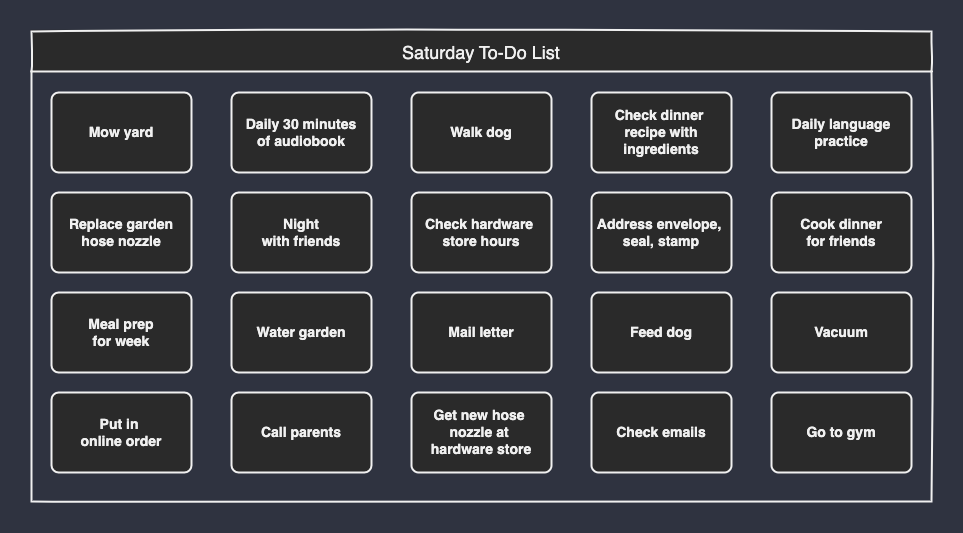
A collection of unorganized tasks can be daunting. It’s hard to know where to start. We might begin doing whatever looks easiest. Or we might procrastinate doing anything, to avoid making the uncomfortable decision of where to begin. A random to-do list makes us use extra energy, because we repeatedly have to decide what to do next.
But we can change things quickly.
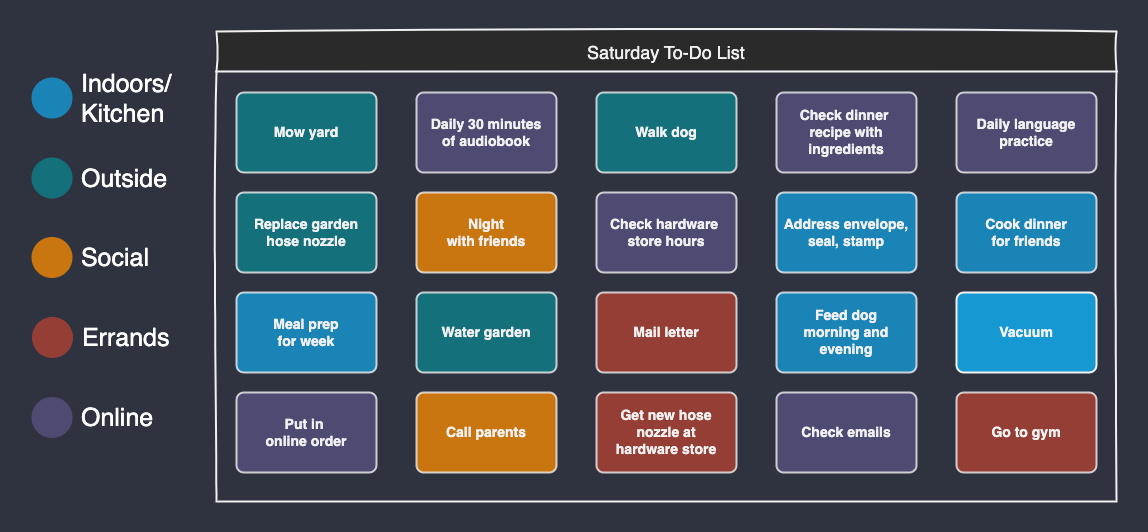
Categorizing our tasks immediately adds a little order to the list. Since this is an example of a Saturday around home, our categories are designed to match the tasks.
Grouping our categories together is a good first step to task batching, so let’s do that.
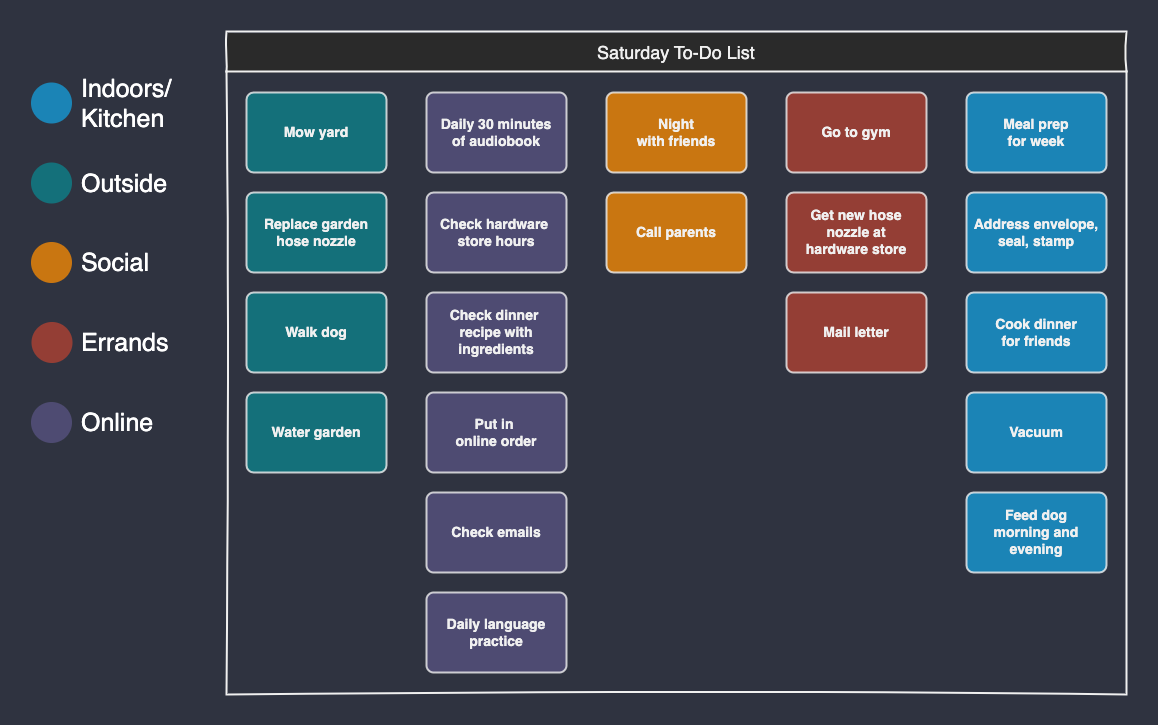
And just like that, our tasks are batched. Now we can easily see how many we have in each category. We should be feeling much more in control already.
But simply batching our tasks by category isn’t always the best use of time and energy. Let’s look at how these tasks might interact.
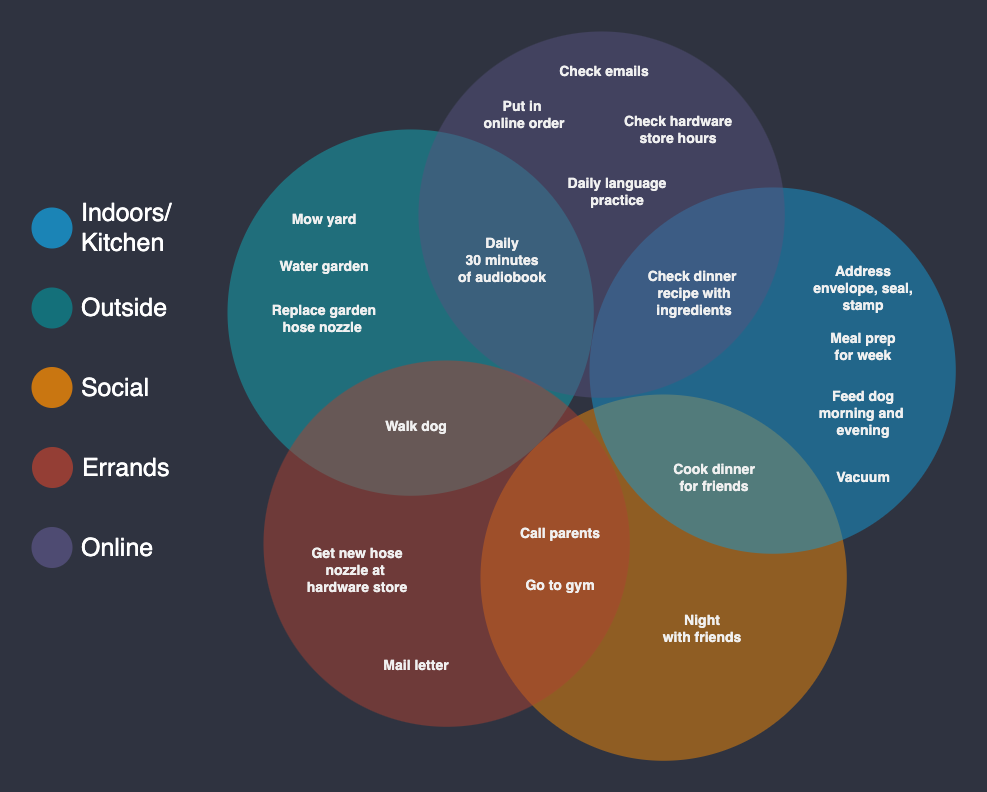
A different perspective reveals the nuance involved in planning our day. Sometimes batching by category is all we need, but often we can customize our batches to save extra time and energy.
Thinking of our day in stages, or chunks, can be helpful when deciding what to group together. These chunks allow our schedule to flow smoother, from one “chunk of tasks” to the next. To help us create these chunks, let’s add some chronological structure with time blocking.
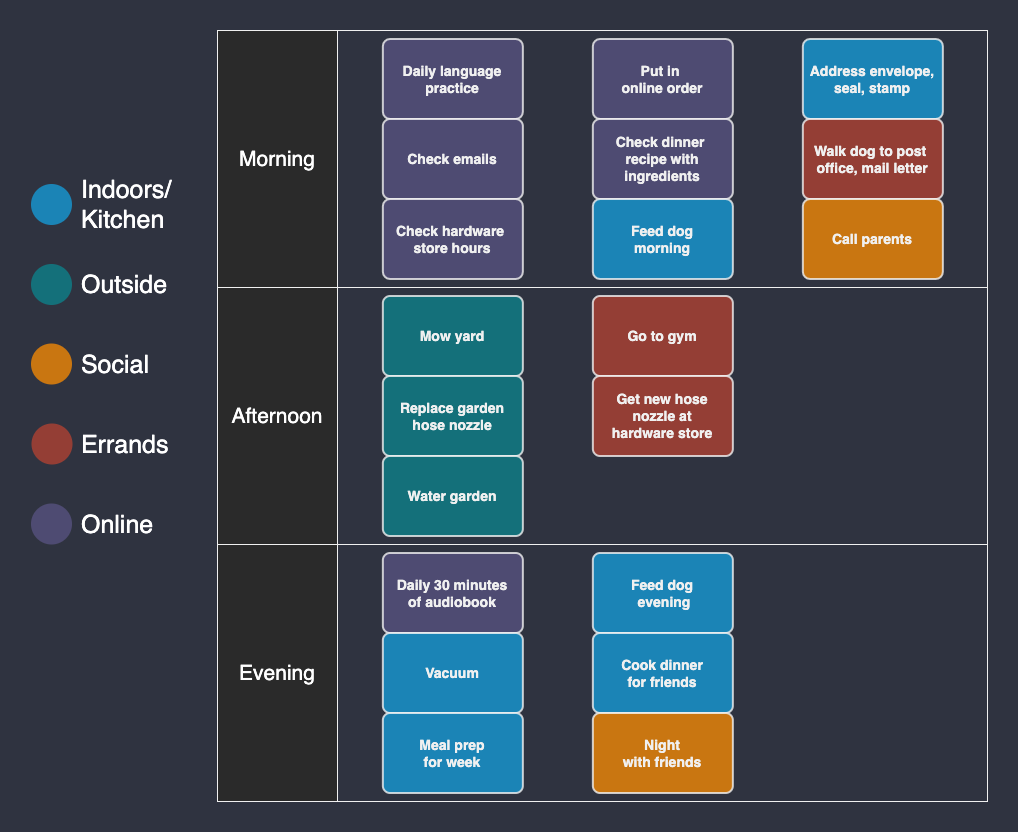
By separating our tasks into three times of day, we’re now using a very basic form of time blocking. Introducing time gives our tasks a rough order to follow. We now know what should be completed by the end of the morning, afternoon, and evening.
We have also began batching tasks that make sense together. These rough groups of three are helping us build an idea of how our day is going to flow from one chunk to the next.
Now that we have a good feel for task batching and time blocking, let’s put our tasks into a schedule, with a specific time and duration for each task.
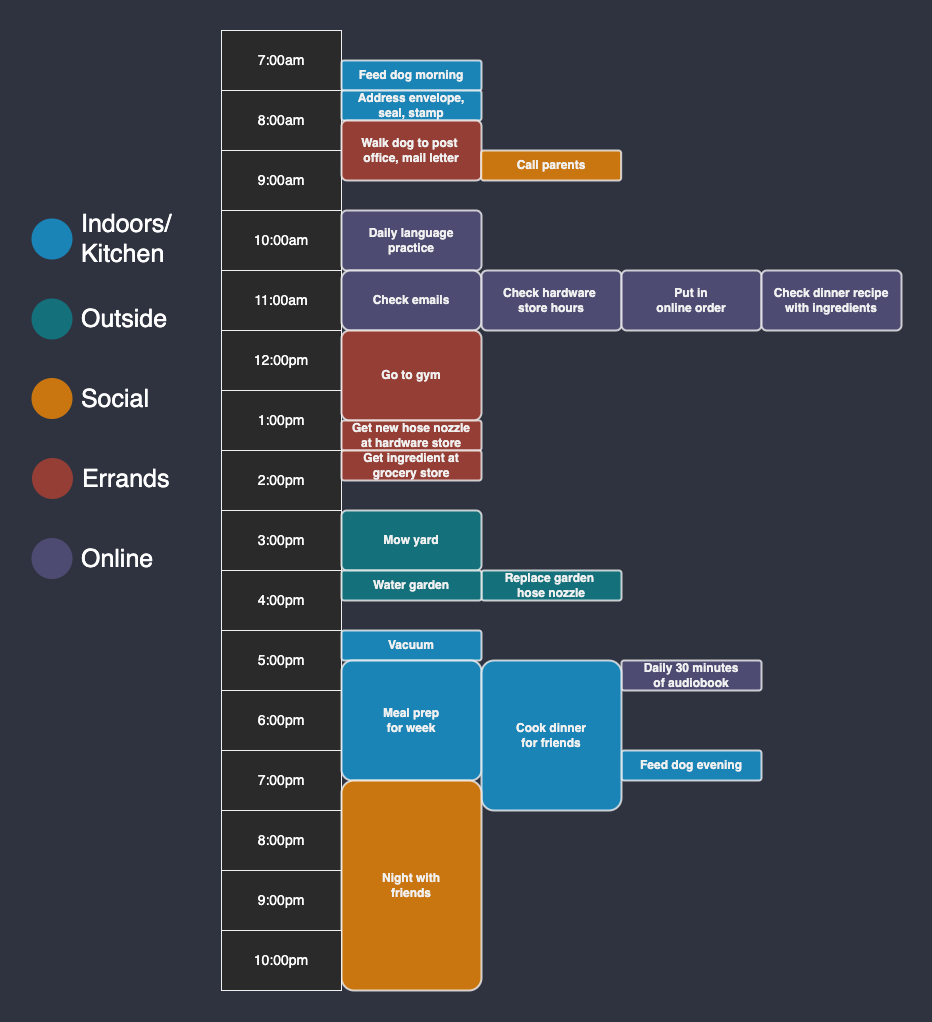
With the addition of a timetable, our batched tasks are now an efficient schedule. We’ve even managed to plan some breaks in our day.
After checking our recipe in the morning, we realized that we need to pick up an ingredient at the grocery store. With our organized schedule, we were easily able to see where it would make sense to add the task (2:00pm).
Let’s look now at the strategies we used to plan our day.
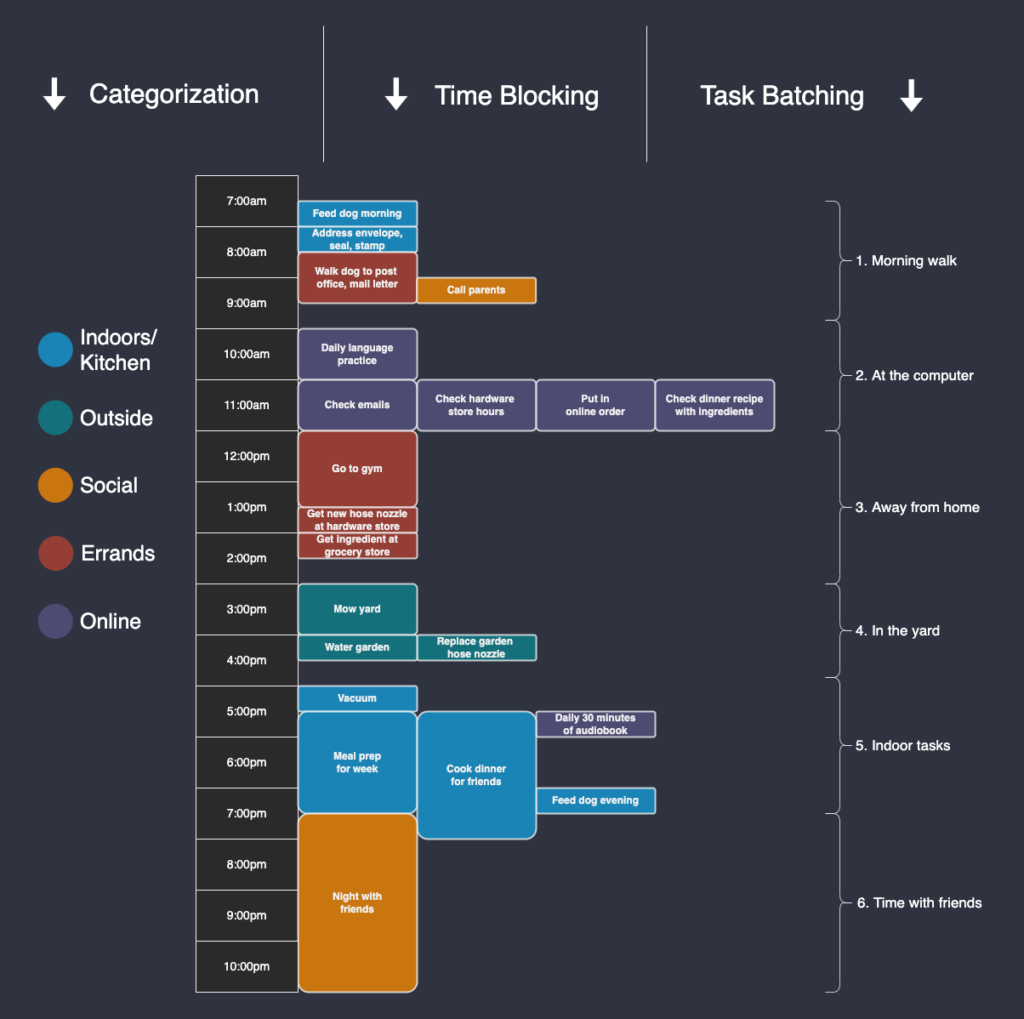
We used categorization to give each task a label.
We used task batching to group tasks in an intelligent way.
We used time blocking to assign each task a specific time and duration.
Categorization adds meaning and organization to tasks. It can greatly help with task batching.
Task batching makes our actions more efficient, by grouping tasks that make sense together. Our Saturday now has 6 chunks: we’re completing 4 tasks during our morning walk, 5 at the computer, 3 away from home, 3 in the backyard, and 5 indoors. Our 6th chunk is more of a reward, where we get to share a dinner and night with friends.
Time blocking gives structure and organization to our day. At a glance, we can see what our day is going to look like, and when we plan on doing each task. We never have to wonder if we should be doing something, because our day has been planned in advance. Last-minute surprises can be easily added to our schedule. Completing 20 tasks during the day allows us to enjoy a worry-free evening with friends.
Final Notes
Estimates
Notice that things like “Going to the bathroom” or “Eating lunch” aren’t scheduled, because we don’t often need to be vigilant about those things—we’re going to fit them in somewhere. It’s a personal preference, but often we don’t want to over-complicate our schedule with tasks that don’t need to be there. But if something is not part of your daily routine, and you want to make sure to do it, even if it only takes 2 minutes, it belongs on your schedule.
With general tasks, you don’t typically need to worry about making their times precise. They’re different from time-sensitive things like work, classes, or appointments. Feeding our dog and addressing an envelope won’t take an hour combined, but they do in our schedule. That’s likely when we would also have breakfast and shower. Of course you can try time blocking your normal daily duties like that—these are personal preferences—just don’t feel like you need to.
Some tasks overlap on our schedule. During our 11am–12pm block above, we’re not going to be doing four tasks at once, rather those are the four tasks we want to complete during that hour. Checking the hardware store hours will take less than five minutes, but rather than worry about precise placement, batching those four tasks over the course of an hour is much easier. It’s the same while cooking in the evening. Depending on what we’re cooking for our meal prep and for our dinner with friends, we may batch all of it together, complete one before moving on to the other, or work on one while the other is cooking/baking.
Don’t Sweat the Small Things
Try and give yourself extra room and breaks wherever you can. Despite our best efforts, days will be unpredictable. A schedule that allows for unexpected events is actually more robust and reliable. When first adopting a time-blocked schedule, we may have to take wild guesses at how long a task is going to take. But estimation skills will improve over time.
